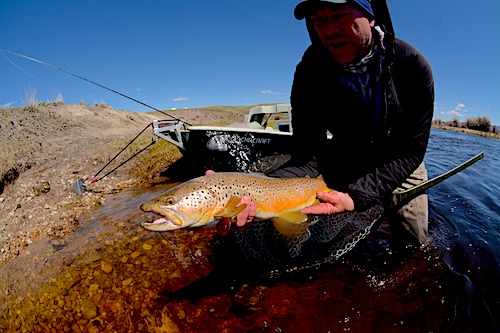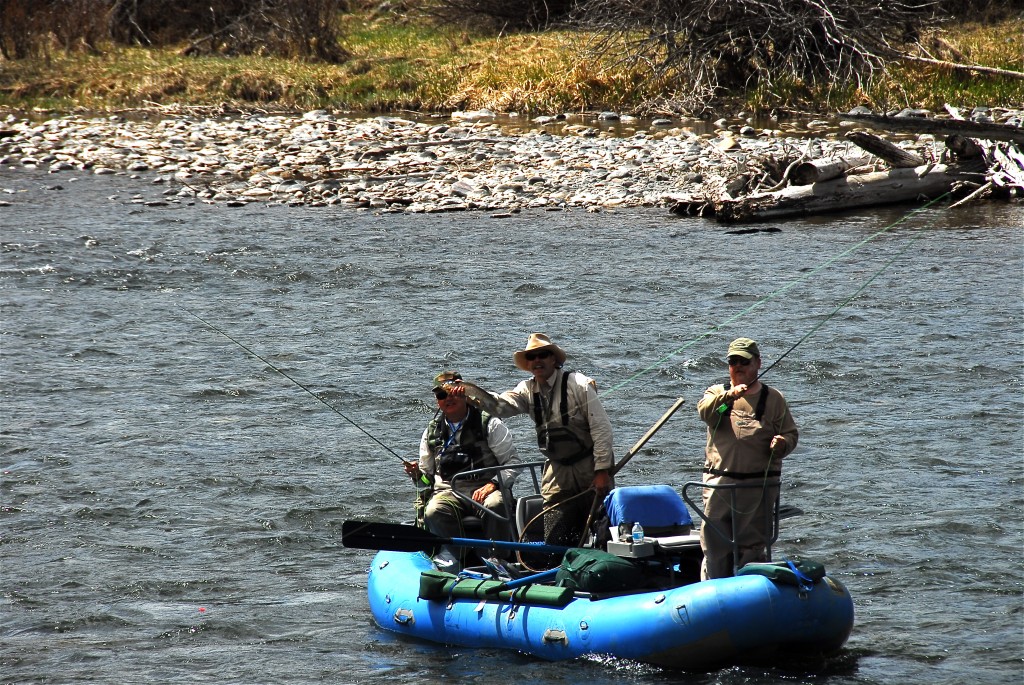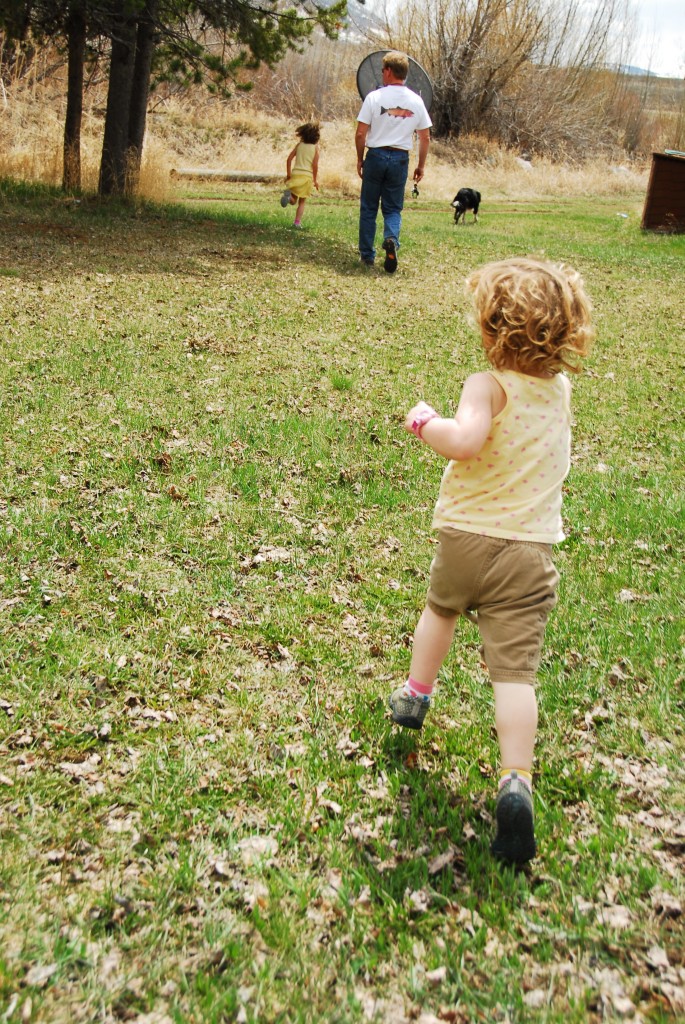The water is up this weekend and some rivers probably aren’t fishable at this time. Others will be on the marginal side, but may offer some opportunities to fish streamers. All you need is a foot or two of visibility and those bank-hugging browns and rainbows can find your flies. Just don’t yank them back to the boat at warp-speed. Give the fish a chance to catch up.
A few years ago I wrote this post on Kelly Galloup’s streamer tactics, and the flies he likes best to tie and fish. Thought this post on Galloup and his streamers would be timely, given the rise in river levels. If you are headed out this weekend, be careful and make sure to pack some of Galloup’s best streamers with you. Fish the banks and see what you can dredge up.
One person who isn’t afraid to admit his fascination with giant trout is a fish assassin named Kelly Galloup who lives on the banks of Montana’s Madison River and runs a fly shop and lodge called Slide Inn.
His main interests are big trout, big trout, and big trout. Fortunately for us, creating and thoroughly testing progressive streamers that catch those giants is also part of his MO. Much of his work and theory is contained in the groundbreaking book, Modern Streamers for Trophy Trout. .
A while back I visited Galloup at his shop, stole a couple Kettle House ambers from his refrigerator that says, “No self-service” and queried him on the new wave of “living” flies, plus his theories on trout behavior and his new Streamer Express fly lines. Sit back with your own favorite libation and prepare to learn.
What are you trying to achieve with your so-called “living flies,” and how do they perform differently than, say, a standard Woolly Bugger?
“The articulation in my flies is based on a back-and-forth and side-to-side S-swim, which is the way prey-fish swim, and that is a trigger-point for big trout. If you combine the side-to-side movement with tipping up and down, it’s even better. I try to create flies that offer multiple trigger-points so a fish says, “I’ve got to ‘F’ this thing up.
“You’ll still catch fish throwing Buggers and other streamers and you may get lucky and catch a good trout, but you won’t trigger a response from the really big fish that someone with a more aggressive multiple trigger-point fly would. You would be limiting yourself, missing an opportunity to see more and bigger fish by only fishing the standard streamers.”
How, exactly, do you achieve that trigger-point movement?
“I basically mimic a jointed Rapala. But the key to my flies is the articulation style; I run a loop of braided stainless off the front hook and attach it to the back hook, which has a flat ring eye. Originally, guys put a hook behind another hook to create the first articulated flies. It made flies longer, but it didn’t make them swim differently. When I added the flat eye back hook everything came together.”
Which pattern is your favorite?
“The Boogie Man is my favorite. By placement of material, including the flank feathers, which hold water, and the weighted head, it articulates side-to-to side and up and down. What that creates is a fish that looks injured and is trying to flee. The Boogie Man is moo, moo, moo, money!”
So Galloup, you catch a lot of big trout—not as many as me, of course—but your fair share. Why would the biggest trout resist nymphs and dries and only eat the “living flies” with multiple trigger points?
“First, f*** you Thomas. Second, give me some money for that beer you pilfered from my ‘fridge.
“Finally, my entire theory developed years ago when I dove the rivers and watched fish. We (anglers) have been trained to think about fish food and match the hatch. The big fish don’t play by that. They are mostly nocturnal. They feed when we aren’t fishing. So, you go underwater and watch them and they have these baitfish around them all the time, and they’re not eating them. They’re like grizzlies; a lot of animals walk past grizzlies and don’t get eaten, but you put an idiot in Yellowstone who runs from a bear and trips over himself and the next day you have a compelling headline in the Bozeman Chronicle. Big fish are like that; they are programmed to feed only at certain times so you need a bunch of trigger-points to get them to eat when otherwise they wouldn’t. For instance, I saw a brown trout a guy caught on the Boogie Man and killed and it had a 12-inch rainbow in its stomach. Do you think that fish needed to eat? It was triggered to eat.”
How come these “living flies” work better than exact renditions of a particular food item?
“I’m not as concerned about visual exactness as I am about multiple trigger-points. I want it to be close enough to be eaten—that’s why I like two tone colors that are nearly exact—but it doesn’t have to be super lifelike. I’m a marabou and hair guy. Think about the Sex Dungeon. The fly, Thomas. Not something else. I don’t have a clue if the Sex Dungeon is a sculpin, a crayfish or a mouse running away. Who cares? There are multiple triggers built in and big fish eat it.”
What do you think about the guys who would say that fishing streamers in general, and especially these new “living flies” isn’t fly-fishing?
“I don’t tend to listen to those people. They are the people who drive newcomers away from this sport. They want all the water for themselves. I find it perplexing to hear those guys say that because they fish dry flies they have ascended to the top of their sport. Most of those dry-fly purists couldn’t fish their way out of a hatchery raceway.”
Kelly. Tell me how you really feel. Open up a bit, please.
“I grew up in the Swisher/Richards world. I love fishing dry flies and I wrote a book about it, Cripples and Spinners. I know what it’s all about, but I don’t limit myself to one way or another. How boring. Why should any of us have to limit our technique. I hear guys saying that what I do is close to bait fishing. Great. Look at the kids coming into the sport wanting to throw streamers, versus those who want to sit on the bank with a thumb up their ass waiting for a hatch.
“When was the last time these purists caught a 10-pound trout on a dry fly? When was the last time they caught a five-pounder on a dry fly? It happens, but not often. I say, if you can do that over and over with a dry fly, show me. If you can repeat like that I’ll quit streamer fishing. I can catch a fish like that every week or two and it’s just fun. It’s a blast to hammer big flies all day.”
You figured out what type of fly line and taper would most efficiently throw big streamers and Scientific Anglers teamed with you to create the Streamer Express. What kind of advantage does the Streamer Express give you over other line styles and tapers?
“The big misconception is that these lines are heavy. They’re made out of Tungsten and they are not heavy, but they are skinny and fast. For the most part I fish in less than 18 inches of water, but these lines allow me, depending on the retrieve, to fish from four inches below the surface to four feet below the surface.
“The heads on these lines are long, 40 feet on the 200 grain Streamer Express, which is designed for a 6-weight rod. That allows me to pick up these flies quickly and, ironically, the beginners who try these lines cast better than they do with floaters. In addition, that long head keeps the fly at the same depth, right where you want it, for most of the retrieve.”
Which Streamer Express line would you fish if you could only fish one?
“The 200-grain is the one I fish 90 percent of the time. I fish it on a 6-weight and I would fish it on a 7-weight, too. I keep a 250-grain with me, but only use it during super high-wind situations or if I fish a heavy, heavy fly. Nine times out of ten, though, it’s the 200-grain.”
Kelly, thanks for the time and the great information. Unfortunately, I’m not paying for those beers.
“Then I guess you’re not walking out of here on two legs. You’re going to look like the Boogie Man after a six-pound brown slams it!”



